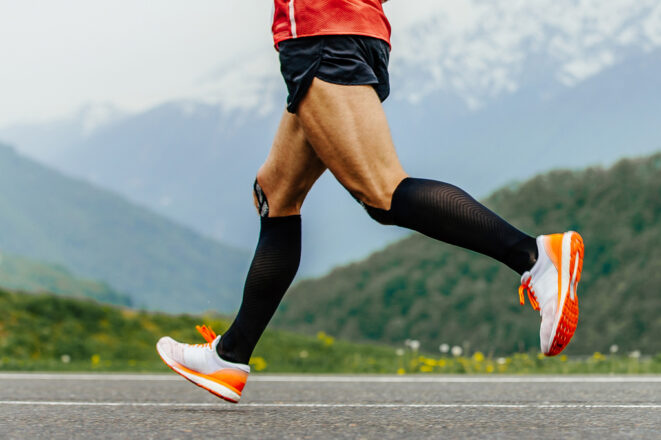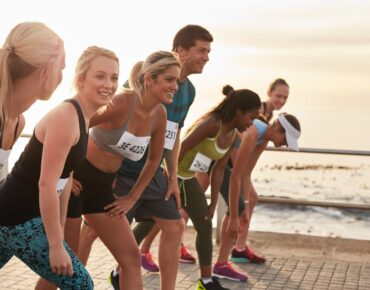Running a 50k isn’t for the faint-hearted. 50k in miles is a whole lot of running. But if you’ve already run a marathon or two and feel ready for the challenge, we’re here to help you get there.
If you’re set on running an ultramarathon and train for it the right way, you can make it to the finish line with a good time. More than that, it will be an unforgettable experience.
Read on to find out how far 50K in miles is and how to prepare for an ultramarathon.
In This Article:
How Many Miles Is 50k?
Let’s start with the basics. How much is 50k in miles exactly? 50km in miles is 31.07 miles.
That’s only 5 miles or about 8 kilometers longer than a marathon. Easy is not the right word for it, and neither is impossible.
There’s a catch. 50k races can be road races, but often, they are trail races. 50k trail races are far more challenging than road running. Those extra miles (or kilometers) across uneven, rugged terrain take the running experience to a new level.
Now that you know how long 50k in miles is, let’s get practical about how you can prepare for it.
Marathon to Ultramarathon
If you’ve completed at least one marathon so far, you have endurance and the experience of a long and challenging race. That’s a good base on which to start preparing for an ultramarathon.
Opting for a 50k trail race will heighten the experience as each trail can come with its own set of challenges. Some of the things you can expect include hill running and crossing streams.
Slowing down and speeding up at the right moments is crucial during a 50k. You simply can’t expect a level and gentle trail from beginning to end, even though some ultramarathons are less demanding than others.
Knowing what 50k race you are going to run and studying the trail a bit if possible – even if you do it from a distance – will make running your first ultramarathon easier.
This way, you can integrate into your training more of the types of challenges you’ll be facing – for example, hill running.
How Long Does a 50k Run Take?
Depending on the terrain, you can expect to run a 50k race around 20% more slowly than a road marathon. A rugged trail with high vertical gains may further add to your finish time.
To estimate your 50k time, you can add around 30 seconds per mile to your average marathon time. That could mean a 50k race time of anywhere between 5 to 7 hours, depending on your age, gender, fitness, and training.
Tip: You can use a race predictor calculator to estimate your ultramarathon finish time based on recent run data. Keep in mind that the result is only a broad estimate subject to terrain variations and other factors.
When it comes to running your first ultramarathon, it helps to focus on building the endurance to get to the finish line rather than worrying too much about your finish time.
How to Prepare for a 50k Race?
A 50k training plan looks a lot like a marathon training plan. Adding about 10–15% more running to your marathon running plan can help you prepare for a 50k road race. Bear in mind, though, that it may take 6 months or more to prepare for an ultramarathon.
Another approach is to run 20–30% more time than your desired finish time. So, if you want to finish a 50k in 7 hours, you want to run about 9 hours during the week.
Ultimately, how much running you build into your plan depends not only on the finish time you’re aiming for but also on your fitness level.
Strength training, tempo runs, and legwork are all important. You want to add them into the mix if you haven’t already. They will help you build strength and endurance.
For example, explosive-strength training that includes sprinting and jumping exercises can increase muscle power and running economy.
Tip: For a personalized 50k training plan, check out the Joggo app.
How Much Should I Train for a 50k Race?
With most ultramarathon training plans, expect to run 4–6 days a week. That can add up to 40 miles or 9 hours per week, sometimes more.
Don’t forget to plan rest days. You need at least 1–2 rest days during the week to give your body time to recover. During these days, you could do gentle cross-training like light yoga.
Having any injuries such as iliotibial band syndrome that causes hip abductor weakness may call for a specialized rehabilitation plan before you begin training. The same often applies to other running injuries.
You need to be at your best to train effectively for an ultramarathon. Ignoring running injuries at this point is not a good strategy.
In the end, there’s no one-size-fits-all training plan for a 50k race. If you aim to just finish an ultramarathon, you still need to train to build endurance. If you want to finish with a good time, you have to sweat for it. And not only on the road or trail but also in the gym.
Your Running Diet for a 50k Race
Think of food as fuel that can help you train and get through a 50k race. Eat right, and you’ll be helping your body perform at its best.
Sports nutritionists recommend a diet that consists of 60% carbs, 25% fat, and 15% protein for ultramarathon runners. This is the diet you want to aim for during your 50k training.
Even if one of your goals running a 50k is burning fat, you have to eat right to actually burn it. Don’t skip breakfast and eat balanced and varied foods, including nuts, fruits, vegetables, and whole grains.
If you have to choose between orange juice and eating an orange, opt most of the time for the food closer to the source. The orange isn’t only juice; it has fiber and will make you feel full for longer.
Tip: To speed up your metabolism and maximize fat burning, eat two hours before exercise. Then eat low glycemic food after exercise. In general, eat foods with a high content of fiber and water.
Taking a supplement for runners can also help you get ready for an ultramarathon. But you want to avoid excess doses. More than the recommended dose won’t mean better performance and could have side effects.
Top Tips for Running Your First Ultramarathon
While you’re getting ready to train, here are some things to remember. They can make a big difference.
Enjoy the challenge
Preparing for your first ultramarathon is an experience you’ll never forget. But the race itself can be unpredictable, especially if you’re running a trail 50k race.
Discomfort is unavoidable. Some parts of the race will feel like a slow grind. But the richness of the experience will change you. You’ll come out of it a stronger runner.
Prepare yourself for the unpredictable by embracing all the challenges of training for and running a 50k. Think of it all as a healthy struggle, not against others, but against impatience and your comfort zone.
Right running gear
A 50k race calls for more gear than a marathon. If you’re running on the trail, marathon running shoes won’t do. You need not only cushioning but also protection and traction that matches the terrain you’ll be running on. Buying several pairs and using the most comfortable one is a good idea.
You’ll most likely have to carry hydration and snacks, so having a running backpack comes in handy too.
Depending on the type of race, weather, location, and other factors, you may also need a water-repellent running jacket. Plus sunblock, sleeves for warning your arms, and moisture-wicking headwear.
Long runs in your training plan
The time you spend on your feet is important when you’re preparing for an ultramarathon. A weekly long run is a key feature of most 50k training plans.
But rather than thinking of long runs only in terms of miles, aim to keep running between 3 to 5 hours or according to your training plan.
Time on your feet will help you build the endurance to run an ultramarathon. It will train your body to handle a lot of running without counting the miles all the time.
Strength training
Two strength-training sessions per week can make you stronger. But you don’t need to do all-out training. Keeping your strength training low to medium in intensity will prevent fatigue.
Work your core, legs, and upper body. Balanced muscle groups will make you a better, more confident runner. They will also help you manage the terrain variations that come with trail running.
Strength training increases time to exhaustion in well-trained long-distance runners, according to research. In the study, well-trained runners did four sets of four half-squats three times a week, in addition to their usual endurance training. As a result, they developed a better running economy.
Keep refueling
You can burn 150 calories per mile during a 50k race. That can add up to well over 4,000 calories per race. Starting race day with a healthy meal is important. But just as important is continuing to refuel during the race.
Many ultramarathons feature aid stations with fruit, chips, sandwiches, and other real food. Get into the habit of eating these during training.
You should also have energy snacks, gels, and a hydration pack or bottle. Practice running with these supplies and using them during your longer workout runs so that you get into the habit of refueling.
Recovery
We’ve left one of the most important aspects of preparing for a 50k last – recovery. Ultra runners are only as good as their recovery plans.
You may train hard and eat well, but if you don’t sleep enough and build rest days into your training plan, you won’t be running at your best. You may not even make it to race day.
Pay attention to your body, which will demand more rest as you go deeper into your training plan. Get at least 7–8 hours of rest every night.
Speed up muscle recovery by not pushing yourself too hard during cross-training. Also, use muscle relaxation techniques like foam rolling.
Yoga and meditation can aid recovery too. Like many other long-distance runners, you may also find compression stockings and other related gear useful.
In the end, training for and running a 50k ultramarathon is going to be an unforgettable experience. One of the defining experiences of your life as a runner. Make every step and every bit of effort count.
Most of all, enjoy it. Listen to your body, stay realistic, and train, run, eat, and rest smart. Running an ultramarathon is not about being the fastest or the strongest. It’s about keeping on going when the going gets tough. And there’s something beautiful in that, something unforgettable.
References:
- Knechtle, B., 2012. Ultramarathon runners: nature or nurture?. International journal of sports physiology and performance, 7(4), pp.310-312.
- O’Loughlin, E., Nikolaidis, P.T., Rosemann, T. and Knechtle, B., 2019. Different predictor variables for women and men in ultra-marathon running—the wellington urban ultramarathon 2018. International journal of environmental research and public health, 16(10), p.1844.
- Alcock, R., McCubbin, A., Camões-Costa, V. and Costa, R.J., 2018. Case study: providing nutritional support to an ultraendurance runner in preparation for a self-sufficient multistage ultramarathon: rationed versus full energy provisions. Wilderness & Environmental Medicine, 29(4), pp.508-520.
- Tiller, N.B., 2019. Pulmonary and respiratory muscle function in response to marathon and ultra-marathon running: a review. Sports Medicine, 49(7), pp.1031-1041.
- Khodaee, M. and Ansari, M., 2012. Common ultramarathon injuries and illnesses: race day management. Current Sports Medicine Reports, 11(6), pp.290-297.
- Nikolaidis, P.T., Knechtle, C., Ramirez-Campillo, R., Vancini, R.L., Rosemann, T. and Knechtle, B., 2019. Training and body composition during preparation for a 48-hour ultra-marathon race: a case study of a master athlete. International journal of environmental research and public health, 16(6), p.903.














